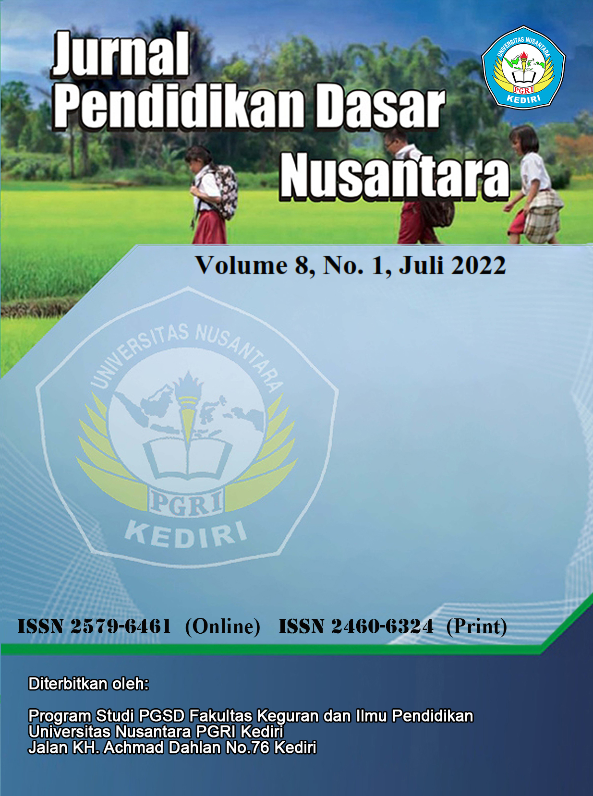ANALYSIS OF PSYCHOANALYSIS THEORY IN ELEMENTARY AGE CHILDREN ANALYSIS: JOURNAL SINTA 2 TO 6
DOI:
https://doi.org/10.29407/jpdn.v8i1.17046Keywords:
Theoory, Psychoanalysis, Elementary age childrenAbstract
The purpose of this study is to see the analysis of psychoanalytic theory in elementary age children, which consists of three parts of personality, namely the id, ego and super ego. The method used by the researcher is descriptive qualitative in a literature review approach. using the method of using data or related scientific papers using the object of research or collecting data that is library in nature and then identified using relevant library materials. Literature review means the activity of conducting relevant research using theories that can be found in the literature, reports by searching, reading and describing. The data collection technique in this study uses journal articles literature, the web or the internet, or other sources and takes from articles related to the discussion of psychoanalytic theory and optimizes the superego to produce students' character in a better personality. which have been published in the journal Sinta 2-6 as many as 6 scientific articles. Then process and conclude research without going through field research. The results of this study are maximizing the super ego in character education to control the super ego to prevent the id's ability to grow in humans.
Downloads
References
Ahmad, M. (2017). Agama Dan Psikoanalisa Sigmund Freud. Religia, 14(2). https://doi.org/10.28918/religia.v14i2.92
Baga, M. (2021). Dua Sisi Kepribadian Bertolak Belakang: Psikoanalisis Freudian dalam Novel Deviasi Karya Mira W. Ideas: Jurnal Pendidikan, Sosial, Dan Budaya, 7(2), 87. https://doi.org/10.32884/ideas.v7i2.364
Hariyanto, I. (2016). Etika Psikoanalisis Sigmund Freud Sebagai Landasankesalehan Sosial. Jurnal Al-Tazkiah, 5(2), 97–107.
Husada, M., Nuruddin, & Lustyantie, N. (2017). Aktualisasi Diri Pada Tokoh Utama Dalam Novel Pasung Jiwa. BAHTERA : Jurnal Pendidikan Bahasa Dan Sastra, 16(2), 15–34.
Husin, H. (2018). Id, Ego Dan Superego Dalam Pendidikan Islam. Al Qalam: Jurnal Ilmiah Keagamaan Dan Kemasyarakatan, 11(23), 47. https://doi.org/10.35931/aq.v0i0.3
Husna, F. (2018). Aliran Psikoanalisis Dalam Perspektif Islam. SALAM: Jurnal Sosial Dan Budaya Syar-I, 5(2). https://doi.org/10.15408/sjsbs.v5i2.9411
Istati, D. (2019). Membentuk Karakter Bangsa Sejak Usia Dini. JKKP (Jurnal Kesejahteraan Keluarga Dan Pendidikan), 6(01), 66–76. https://doi.org/10.21009/jkkp.061.09
Matlin, M. (1999). Psychology (3rd editio). Orlando: Harcourt Brace College Publishers.
Minderop, A. (2010). Psikologi Sastra: Karya Sastra, Metode, Teori, dan Contoh Kasus. Yayasan Pustaka Obor.
Nofrita, M., & Hendri, M. (2017). Kajian Psikoanalisis dalam Novel Pria Terakhir Karya Gusnaldi. Jurnal Pendidikan Rokania Riau, 2(1), 79–89.
Purnamasari, D. (2017). Pendidikan Karakter Berbasis Al-Quran. Islamic Counseling: Jurnal Bimbingan Konseling Islam, 1(1), 1. https://doi.org/10.29240/jbk.v1i1.233
Putri, D. P. (2018). Pendidikan Karakter Pada Anak Sekolah Dasar Di Era Digital. AR-RIAYAH : Jurnal Pendidikan Dasar, 2(1), 37. https://doi.org/10.29240/jpd.v2i1.439
Rachmadyanti, P. (2017). PENGUATAN PENDIDIKAN KARAKTER BAGI SISWA SEKOLAH DASAR MELALUI KEARIFAN LOKAL Putri Rachmadyanti Universitas Negeri Surabaya A . Pendahuluan Seiring kemajuan zaman dengan perkembangan ilmu dan teknologi yang pesat , mendorong manusia untuk selalu berkemba. Jurnal Pendidikan Sekolah Dasar, 3(2), 201–214.
Rakhmat, J. (2008). Psikologi Agama Sebuah Pengantar. PT RajaGrafindo Persada.
Sahara, D. (2019). Hasrat Kurniawan Dalam Novel Seperti Dendam, Rindu Harus Dibayar Tuntas (Kajian Psikoanalisis Jacques Lacan). Jurnal Salaka, 1(2), 2–16.
Saleh, A. A. (2018). pengantar psikologi. Aksara Timur.
Sembiring, R. H., Herlina, H., & Attas, S. G. (2018). Kepribadian Tokoh Utama dalam Novel Negeri Para Bedebah Karya Tere Liye Kajian Psikoanalisis Carl Gustav Jung. Transformatika: Jurnal Bahasa, Sastra, Dan Pengajarannya, 2(2), 157. https://doi.org/10.31002/transformatika.v2i2.788
Semiawan, R, C. (2009). Penerapan Pembelajaran Pada Anak (4th ed.). Indeks.
Sumadi, E. (2018). Anomali pendidikan karakter. Tarbawi : Jurnal Pendidikan Islam, 15(2). https://doi.org/10.34001/tarbawi.v15i2.846
Urip, K. M., & Maemonah. (2021). Analisis Hierarki Kebutuhan Maslow Dalam Pembelajaran Daring Anak Usia Dasar: Analisis Jurnal Sinta 2 Sampai 6. AULADUNA: Jurnal Pendidikan Dasar Islam, 8(1), 51. https://doi.org/10.24252/auladuna.v8i1a5.2021
Wahab, Nurulhidayah Abu Bakar, A. M. bin M. A. (2017). Analisis Elemen-Elemen Nafsu Dalam Teori Psikoanalisis Sigmund Freud Dan Kitab Penawar Bagi Hati Al-Mandil. Jurnal Islam Dan Masyarakat Kontemporari, 14(1), 206–219.
Widiarti, P. W. (2013). Pendidikan Karakter Berbasis Empati Pada Anak-Anak Usia Sd. Informasi, 39(2), 83–91. https://doi.org/10.21831/informasi.v0i2.4446
Wuryandani, W., Maftuh, B., . S., & Budimansyah, D. (2014). Pendidikan Karakter Disiplin Di Sekolah Dasar. Jurnal Cakrawala Pendidikan, 2(2), 286–295. https://doi.org/10.21831/cp.v2i2.2168
Zaenuri, A. (2005). Estetika Ketidaksadaran: Konsep Seni menurut Psikoanalisis Sigmund Freud (1856-1939). Harmonia: Journal of Arts Research and Education, 6(3), 1–15. https://www.academia.edu/download/40975437/ipi136267.pdf
Downloads
Published
Issue
Section
License
Authors who publish with this journal agree to the following terms:
- Copyright on any article is retained by the author(s).
- The author grants the journal, the right of first publication with the work simultaneously licensed under a Creative Commons Attribution License that allows others to share the work with an acknowledgment of the work’s authorship and initial publication in this journal.
- Authors are able to enter into separate, additional contractual arrangements for the non-exclusive distribution of the journal’s published version of the work (e.g., post it to an institutional repository or publish it in a book), with an acknowledgment of its initial publication in this journal.
- Authors are permitted and encouraged to post their work online (e.g., in institutional repositories or on their website) prior to and during the submission process, as it can lead to productive exchanges, as well as earlier and greater citation of published work.
- The article and any associated published material is distributed under the Creative Commons Attribution-ShareAlike 4.0 International License

































